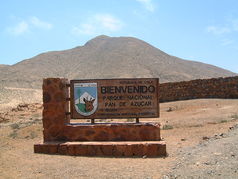Pan de Azúcar National Park
| Pan de Azúcar National Park | ||
|---|---|---|
|
|
||
| Location: | Atacama , Chile | |
| Next city: | Chañaral | |
| Surface: | 438 km² | |
| Founding: | 1985 Chile | |
The Chilean National Park Pan de Azúcar (Spanish Parque Nacional Pan de Azúcar , German: "Sugar Loaf") is located 30 km north of Chañaral , or 180 km north of Copiapó and was founded in 1985. The park covers an area of 43,769 hectares. The park gets its importance from its relative biodiversity. Over 20 species of cacti are found in the area. The absence of precipitation is offset by the coastal fog.
reachability
The usual starting point for a visit is the city of Chañaral . From there, a road along the sea leads to the two beaches of Playa Amarilla and Playa Blanca to the park. Many make this excursion by bike and spend the night in Caleta Pan de Azúcar or camp further up in the mountains.
An alternative route to or from the national park is to switch from Caleta Pan de Azúcar east to the Panamericana . This route is also particularly attractive for those interested in local geology.
Isla Pan de Azúcar
At km 24 you can see the Isla Pan de Azúcar, supposedly the northernmost occurrence of penguins ( Humboldt penguins ) on earth. From the port of Caleta de Pan de Azúcar you can make tours around the island. However, it is not allowed to enter the island itself.
Caleta Pan de Azúcar
Caleta Pan de Azúcar is a small settlement of fishermen who have also taken care of local tourism. In the past, copper was processed and shipped here. Divers can still see parts of the wharf, loading crane and other things underwater. From Caleta you can drive to the 8 km further north located lookout point (Mirador). After visiting Caleta Pan de Azúcar, the main attraction of the park is east of the small bay. There on the slopes you have the best access to the extraordinary fauna of the area, which is kept alive through the use of the coastal fog.
Web links
- Parque Nacional Pan de Azúcar on the CONAF website



